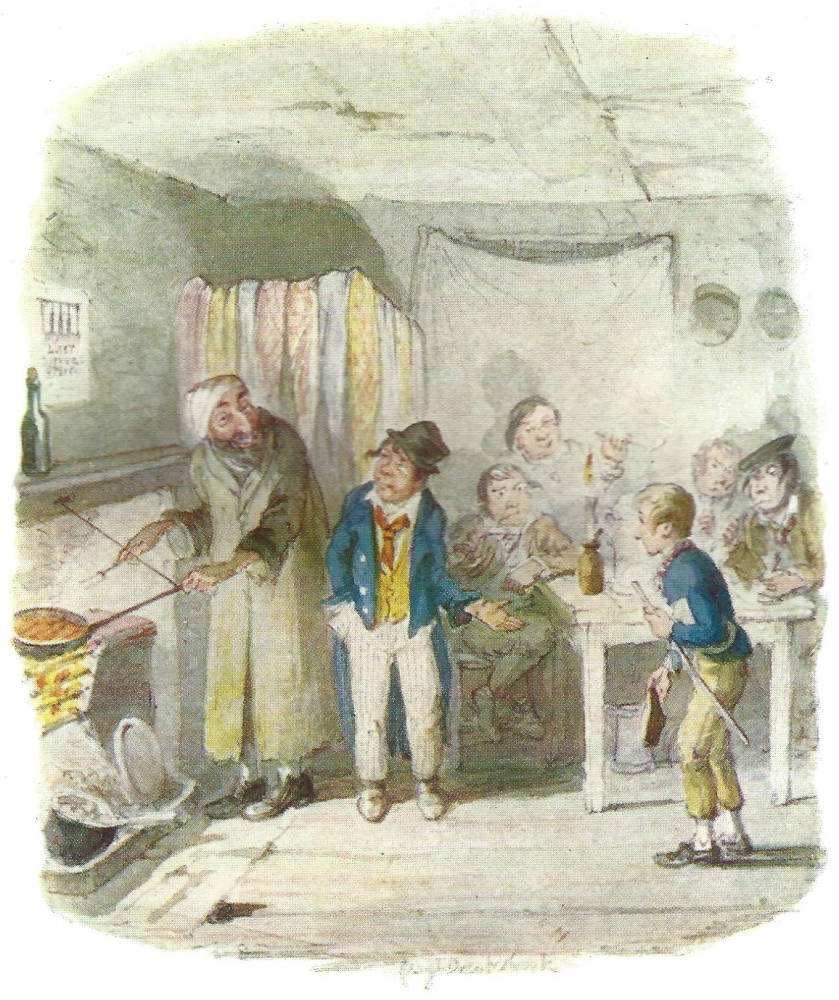These questions were originally created for English 394: The Victorian Novel from Dickens to Hardy, at the University of British Columbia, Summer Session Two, 1989. They have been augmented with pertinent excerpts from Tillotson's seminal criticism of the early Victorian novel for English 3412 (Victorian Fiction), Lakehead University, January through May 2004. For additional questions click on the "Contexts" icon at the foot of the screen.
Question 14. Part Twelve: Introductory (pp. 75-76)

Left: George Cruikshank's realisation of the scene in which Jack Dawkins (The Artful Dodger) introduces Oliver to a London "fence," Fagin, and his gang of pickpockets in Dickens's Oliver Twist: Oliver Twist introduced to the respectable old gentleman (Ch. VIII). [Click on image to enlarge it.]
Some of the romantic novelists — Bulwer in Paul Clifford [1830] and Eugene Aram [1832], Ainsworth in Rookwood and Jack Sheppard — carried their sentimental views of character into low life, 2 and these 'Newgate novels' provoked a further and more serious reaction first from Dickens, and then, in a slightly different direction, from Thackeray. 3 In Catherine Thackeray went further in frank sordidness than Dickens in Oliver Twist, but Dickens's exploration proved more fruitful; Catherine, designed as 'medicine' to produce wholesome nausea, proved merely destructive, and has more significance in Thackeray's critical than in his creative writing. Dickens's 1841 Introduction to Oliver Twist shows that he well knew that he was breaking new ground:

Left: George Cruikshank's realisation of the sort of sordid scene that Dickens had mind in William Harrison Ainsworth's August 1839 Jack Sheppard: Jack Sheppard visits his Mother in Bedlam (Vol. 2, Ch. VIII). [Click on image to enlarge it.]
I had read of thieves by scores — seductive fellows (amiable for the most part), faultless in dress, plump in pocket, choice in horseflesh, bold in bearing, fortunate in gallantry, great at a song, a bottle, pack of cards or dice-box, and fit companions for the bravest. But I had never met (except in Hogarth) with the miserable reality. It appeared to me that to draw a knot of such associates in crime as really do exist; to paint them in all their deformity, in all their wretchedness, in all the squalid poverty of their lives; to show them as they really are, . . . would be to attempt a something which was greatly needed, and which would be a service to society. [pp. 75-76]
Notes, Page 75
2 "These two extremes of novel-writing — the almack and Jack Sheppard schools — deviate equally from the standard of real excellence . . . low and humble life are sophisticated just as much as elevated and fashionable" (Blackwood's September 1845, p. 343).
3 The decline of the 'Newgate novel', even on the lowest level of 'penny literature', was noted by Charles Knight in 1846 (The Old Printer and the Modern Press, 1854, p. 281).
Question Fourteen: The Newgate Novel
14. How, according to Tillotson, are The Luck of Barry Lyndon and Oliver Twist reactions to rather than simply examples of the Newgate Novel?
Bibliography
Tillotson, Kathleen. Novels of the Eighteen-Forties. Oxford: Clarendon, 1955, rpt. 1983.
Created 21 October 2003
Last modified 21 January 2024